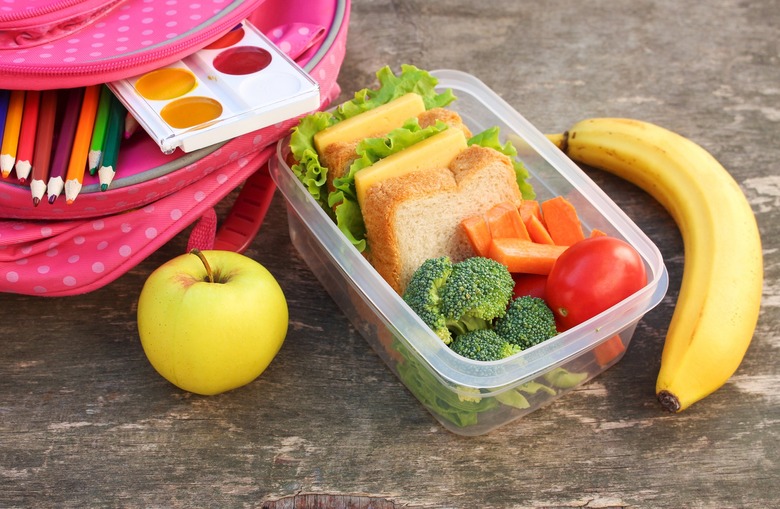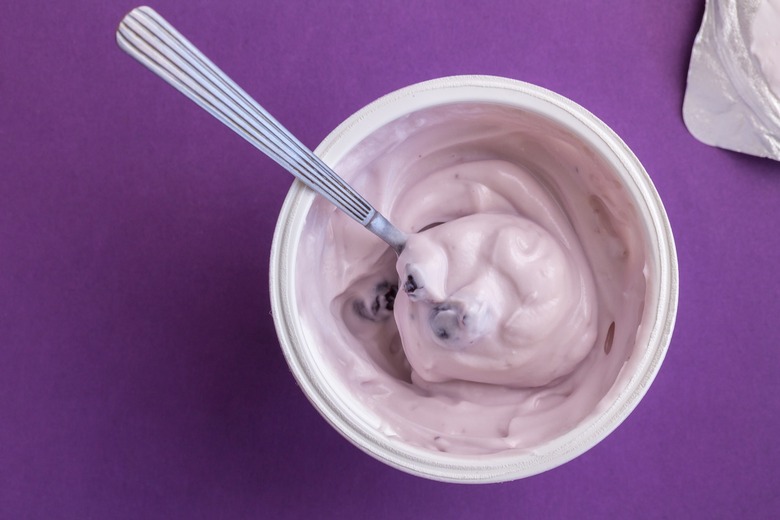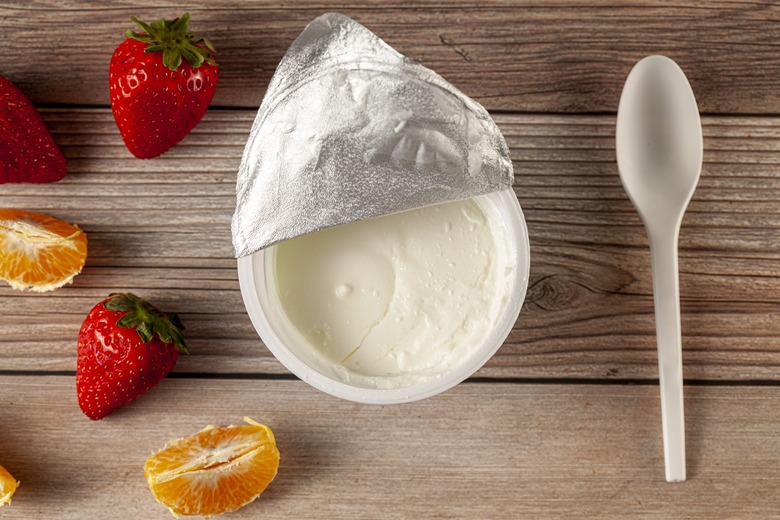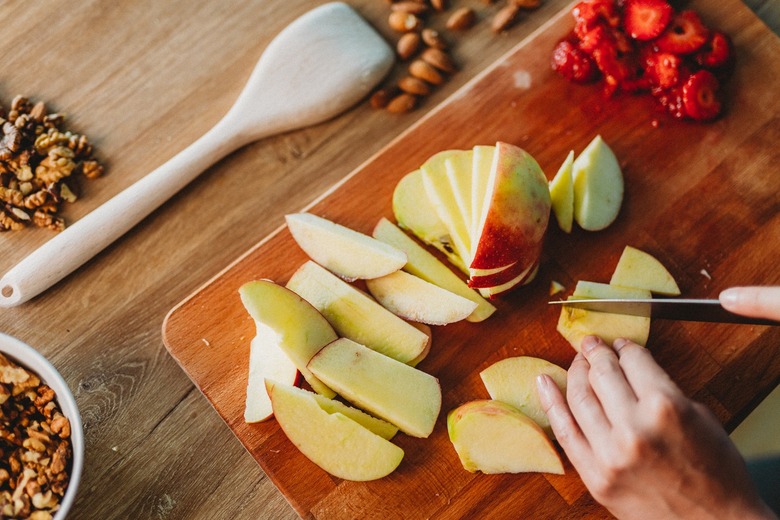How Long Can Yogurt Be In A Lunch Box? And Other School Lunch Questions, Answered
Back-to-school season means your weekday menus go under a total revamp, including quick and easy breakfasts in the morning and simple, kid-friendly dinners at night. And there's also the issue of lunches. Before packing your child's lunch, it's important to think about food safety. How long will yogurt or ranch dressing stay fresh in a lunchbox? Will fried food or condiments on sandwiches get soggy? These are only a few of the many questions parents should ask themselves when thinking about what to put inside their child's lunch box. We have the answers to some common school lunch questions to help parents make the best food choices.
How long can yogurt be unrefrigerated in a lunch box?
You may want to be careful with packing yogurt for your little one. Yogurt can last outside of the refrigerator for about two hours at room temperature. If you leave yogurt out longer than that, bacteria can start to grow. To avoid this, you can freeze your child's yogurt overnight. It can thaw in time for lunch. You also can put it next to an ice pack in an insulated lunch bag. Even when taking these precautions, it still may be helpful to teach your kids some of the telltale signs that yogurt and other foods have gone bad.
Can you freeze yogurt? How long does it take to thaw?
There are some foods you should always keep in the freezer while there are other foods you should never freeze. Yogurt is in the middle of those extremes. If you love buying those single-serve yogurt cups from the grocery store, you can absolutely freeze them. However, you won't get the same smooth consistency when it thaws. Instead, it may appear like cottage cheese. And if you don't mind the texture too much, it's still great to add to a healthy smoothie. Allow at least 24 hours for the yogurt to thaw in the fridge before eating. If you freeze yogurts in a tube like Go-Gurt, the texture won't be affected, and it will thaw by the time your kids sit down for lunch.
How long will food stay hot in an insulated container?
Do you want to pack leftover soup or mac and cheese for your kid's lunch? Insulated food containers, like the ones made by Thermos, are great products. But will the food stay warm until lunchtime? In general, these containers can keep food warm for up to five hours, although the time may vary depending on the type of container you use. To help keep your child's food warm, you can microwave the food until it's piping hot. Or you can fill the Thermos with hot water and let it sit for a couple of minutes before emptying it to put food inside.
How can you keep food like chicken nuggets warm without getting soggy?
No one enjoys squishy chicken nuggets or soggy mozzarella sticks. If you want to prevent that from happening, an insulated food container will be your savior. If you stuff the bottom of the container with paper towels, it will help absorb any moisture from warm food and keep those nuggets warm until lunch.
How long does it take to thaw a frozen muffin?
No one likes mushy muffins. The best way to counter a soggy snack and keep it fresh is to freeze a batch. A great meal-prepping hack is to keep muffins in the freezer, where they can be stored for up to three months. You'll be able to pack them whenever your child is in the mood for a muffin. Keep in mind that it usually takes an hour at room temperature for the muffin to thaw completely if you plan on putting a muffin into your child's lunchbox.. If your student has access to a microwave, it should take about 30 seconds for the muffin to defrost.
How do you stop bananas from ripening or getting bruised?
It doesn't matter if your bananas are brown and mushy when you're making banana bread, but overripe fruit is less appetizing to eat as-is. If you shove the banana into a lunch box or paper bag, you're storing it wrong. And most likely, the banana will only ripen faster. To avoid this, wrap the top of the banana with tape and plastic wrap to make sure it stays fresh long enough for your kid to enjoy.
How do you prevent soggy sandwiches?
From simple salami to tuna salad, sandwiches are the best option for an easy lunch. However, there are a few things to keep in mind to prevent sandwiches from getting soggy before your kids have lunchtime. As a fail-safe, you can always toast the bread to lessen any fear of soggy sandwiches. If the sandwich includes wet ingredients such as tomatoes or lettuce, make sure to pat them dry to help prevent moisture from soaking into the bread. You can also separate the fillings and have your child build their sandwich come lunchtime.
How do you keep a water bottle from sweating?
If you're the type of person who likes to keep water bottles in the fridge or freezer so that they stay ice cold, you've probably experienced water-bottle sweating. That may not be an ideal situation for your child, especially if they're carrying the bottle around with books in their backpack. You can wrap the bottle in a paper towel and cover it with a bottle sleeve to also help keep the water cool. You and your kids can enjoy a fun, crafty way to absorb moisture by using fresh, fun patterned socks to make homemade bottle sleeves.
How do you keep apple slices from browning?
If you've ever eaten apple slices, you know the dread of a browned apple. Once an apple is sliced or peeled, it only takes a few minutes before the fruit begins to turn into an unappealing brown color. To avoid this, soak your apples in ½ teaspoon kosher salt and 1 cup cool water for about 10 minutes. You can rinse off the apple slices before packing them away into a lunch box or store them in an airtight container for up to a week. These fruit slices can last up to five days in the fridge which makes them the perfect quick and easy after-school snack for your kids.
More from The Daily Meal:
20-Plus Meal Prep Recipes That Will Make Weeknights a Breeze
50 Easy Dinner Ideas for Busy Weeknights
How to Make Your Food Last Longer
Dinner Recipes From Your Childhood That Are Actually Incredible
Homemade Croutons, Pickled Vegetables, Fresh Herbs and More Ways to Upgrade Your Salad









